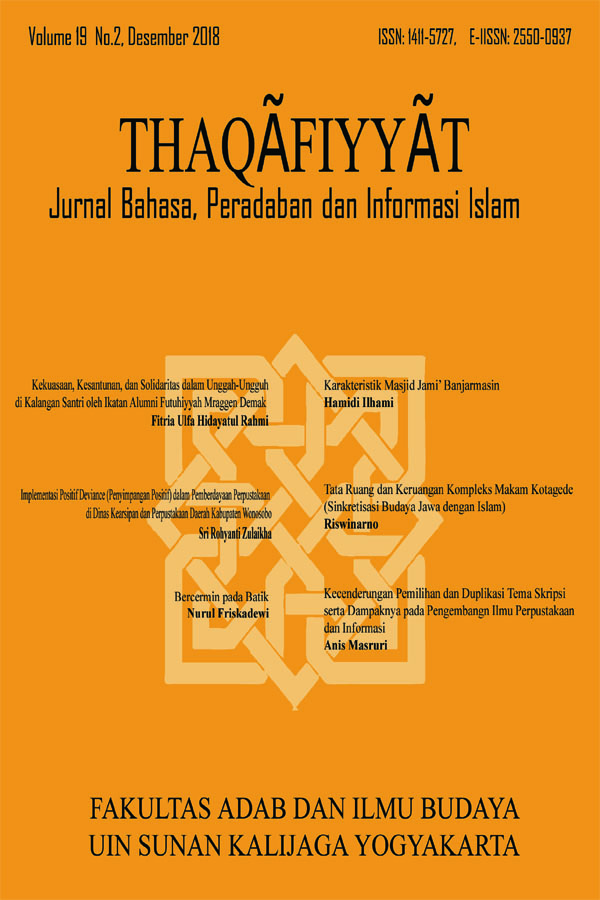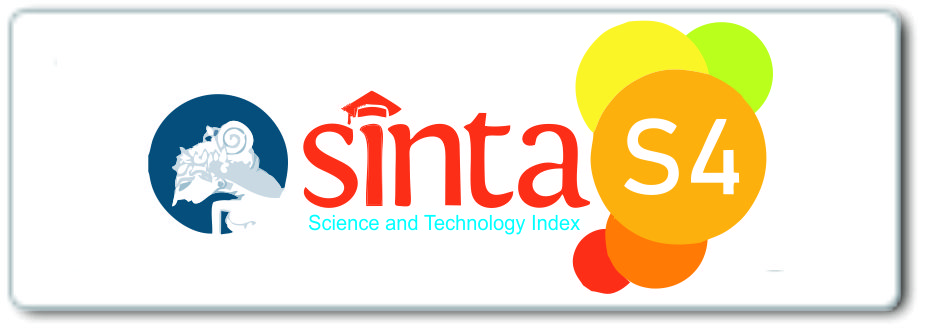BERCERMIN PADA BATIK
DOI:
https://doi.org/10.14421/thaq.2018.19203Kata Kunci:
Diversity, culture, batikAbstrak
Diversity becomes natural to them who have archipelago geographical condition. We may reflect to cultural product as batik. Batik growth in this nation has received many influences. This influences then creatively combined with our culture and still coloring our cultural lives. The purpose of this paper is to describe cultural diversity by reflecting on batik. Currently batik has spread widely throughout Indonesia and become a national and international identity. Adaptation perspective, various influences can be overcome without leaving the authenticity of this nation. This is in line with the spirit “Bhinneka Tunggal Ika”. Again, reflecting on ourselves, batik is only a material culture which rich in meaning, and most important, how values and meaning can inspired us and generations to come.Unduhan
Referensi
Bakwin. 2007. The Art of Indonesian Textiles the E. M. Bakwin Collection at the Art Institute of Chicago. The Art Institute of Chicago / Yale University Press, New Haven and London.
Berg. Encyclopedia of World Dress and Fashion. Global Perspectives. 2010. New York
Bennet, John W.1976. Anticipation, Adaptation, and the Concept of Culture in Anthropology. Vol. 192, No. 4242 (May 28, 1976), pp. 847-853. American Association for the Advancement of Science . Stable URL: https://www.jstor.org/stable/1742130
Brown, A.R Radcliffe. 1952. Structure and Function in Primitive Society. London: Routledge and Kegan Paul
Djumena, Nian S. 1990. Ungkapan Sehelai Batik. Jakarta:Djambatan.
Elliot, Inger McCabe. 2004. Batik: Fabled Cloth of Java. Periplus, 19.
Furnivall, J.S. 1948. Colonial Policy and Practice: A Comparative Study of Burma and the Netherland Indies. Cambridge: Cambridge University Press.
Hamilton, Peter. 1990. Talcott Parsons dan Pemikirannya: Sebuah Pengantar. Tiara Wacana
Geertz, C (1973), The Interpretation of Cultures, Newyork: Basic Book.
Helmi, Alfian dan Arif Satria. 2012. Strategi Adaptasi Nelayan Terhadap Perubahan Ekologis. Makara, Sosial. Humaniora, Vol. 16, No.1, Juli 2012:68-78
Heringa, Rens, Harmen C. Veldhuisen, Dale Carolyn Gluckman and Peter Carey. 1996. Fabric of Enchantment. Batik from the North Coast of Java. Los Angeles Country Museum of Art.
Hitchcock, Michael. 1991. Indonesian Textiles. British Museum Press In association with The Centre for South East Asian Studies University of Hull.
Kina. 2013. Kina Karya Indonesia. Batik Nusantara. Batik of the Archipelago. Jakarta: Kementerian Perindustrian.
Kuswadji. 1981. Mengenal Seni Batik di Yogyakarta: Proyek Pengembangan Permuseuman Yogyakarta.
Lin, Lee Chor. 2007. Batik Creating an Identity. National Museum of Singapore.
Malinowski, B. (1994), A Scientific Theory of Culture. Chappel Hill: Univ Of North Caroline Press.
Mas Pirngadie. 1916. De batik Kunst. Volume 3 De inlandsche kunstnijverheid in Nederlandsch Indie. Mounton and Company.
Parsons, Talcott. 1965. Structure and Process In Modern Societies. New York: The Free Press.
Raffles, Sir Thomas Stamford.1994. The History of Java. Kuala Lumpur: Oxford University Press
Seremetakis, C. Nadia. 1994. The Senses Still. Perception And Memory As Material Culture In Modernity. The University Of Chicago Press. Chicago and London
Spradley & Mc. Curdy, 1975. Anthropology: the cultural perspective. New York: Wiley. hal. 189-190.
Steelyana, Evi. Batik , A Beautiful Cultural Heritage that Preserve Culture and Supporteconomic Development in Indonesia. Binus Business Review, Vol. 3, No.1 2012.
Udiani, Ni Made Ratna Putri. 2016. Batik sebagai Identitas Nasional. Program Studi Teknologi Informasi Fakultas Teknik Universitas Udayana Bali.
http://aikyrizky23.blogspot.co.id/2016/10/batik-sebagai-identitas-indonesia.html sites in 20 March 2018.
http://banyumasnews.com/85493/butik-batik-banyumasan-butik-mungil-di-tengah-kota-purwokerto/ sites in 29 March 2018.
Unduhan
Diterbitkan
Terbitan
Bagian
Lisensi
Hak Cipta (c) 2020 Nurul Friskadewi

Artikel ini berlisensiCreative Commons Attribution-NonCommercial-ShareAlike 4.0 International License.
Authors who will publish with this journal agree to the following terms:
- Thaqafiyyat: Jurnal Bahasa, Peradaban dan Informasi Islam publishes all articles entirely in full text.
- It is permissible for readers to download and to use it for scientific purposes and scientific dissemination.
- Authors retain copyright and grant the journal right of first publication with the work simultaneously licensed under a Creative Commons Attribution License that allows others to share the work with an acknowledgement of the work's authorship and initial publication in this journal.
- Authors are able to enter into separate, additional contractual arrangements for the non-exclusive distribution of the journal's published version of the work (e.g., post it to an institutional repository or publish it in a book), with an acknowledgement of its initial publication in this journal.
- Authors are permitted and encouraged to post their work online (e.g., in institutional repositories or on their website) prior to and during the submission process, as it can lead to productive exchanges, as well as earlier and greater citation of published work.









